Conversion is a critical concept that matters to many of us working in this sector. Or at least for those of us who happen to be faithful users of Google Analytics (GA). How wouldn’t it be so? It’s not just a concept but a whole ideal we long for. What is meant by conversion is, in fact, all the practical actions that visitors perform on our website. Worthwhile how? Well, the steps in question often reflect a particular interest. And someone interested in our websites is much more likely to become a regular customer, don’t you think? And what is all about Google Analytics conversions?
Now, some of you may have noticed that there’s a missing concept in our title. Yes, it’s the one known as the goal. Throughout our article, we will try to understand better what it is. Because, as a matter of fact, conversions and goals are very closely intertwined. We may even consider them synonyms to a certain extent. However, there are also slight differences between them. It all depends on whether one uses Universal Analytics (UA) or the upgraded version, Google Analytics 4 (GA4). As you know, the latter is soon to become the only viable version available (as of July 1st, 2023).
No need to panic, though. We will go step by step for you in order to see how things work in both versions (UA and GA4). That’s how we’ll be able to explore ideas for Google Analytics conversions and goals.
Google Analytics Conversions as a New Gen Tracker
Yes, indeed. Those already familiar with Universal Analytics have probably grasped the differences right away. In fact, the same goes perhaps for new users as well. Google has sort of decided to turn you into ‘goal masters.’ You and you only decide from now on what to set as a goal/conversion and go after. Thanks to the new and improved custom settings, You’re free to do it your way. So let’s welcome a change that finally recognizes each GA user’s specificity and needs. Check Google Analytics 4 guide for more information on the matter.
What Are Goals in Google Analytics?
It’s almost always essential to break down the whole and proceed one by one. So first, let’s try to comprehend what is goal in Google Analytics. Simply put, a goal is what you’re aiming for through your website. In effect, we doubt that you built a site out of the blue with no underlying motivation. There must necessarily be something that you’re trying to accomplish. The thing is, you will need to define and refine those objectives in order to make the best of Google Analytics.
Why is that? You see, there are different types of goals in GA. Depending on what you are pursuing via your website (your objectives), you might need to prioritize some more than others. If anything, you will have to treat them under distinct categories. Let’s thus see which types of goals are available in Google Analytics.
4 Types of Google Analytics Goals
So yes, we may say that there are four main types of GA goals, which are listed hereunder in alphabetical order:
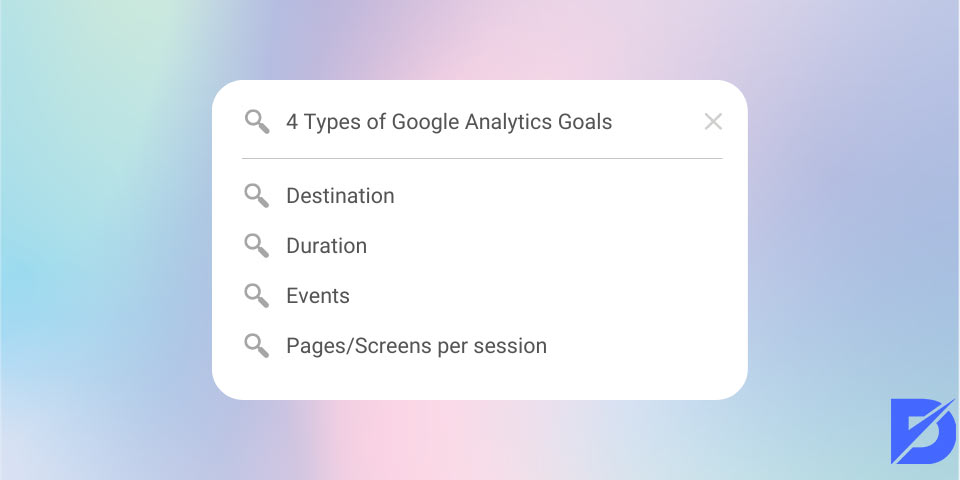
- Destination
- Duration
- Events
- Pages/Screens per session
Let’s briefly remember what each consists in:
Destination: This kind of goal is considered accomplished whenever a visitor lands on a particular page, URL, etc., you wish they visited, hence the term destination.
Duration: Here, the goal is accomplished whenever a session lasts the amount of time you want it to last or longer.
Events: This term is related to almost anything happening on your website, namely… the events taking place. Some examples of events include page loadings, video views, downloads, and purchases.
Pages/screens per session: This goal is achieved every time people visit pages (or screens) more than the specified number.
That’s all there is to know for anyone wondering which goals are available in Google Analytics. So are we done here? No, not exactly. Remember our initial focus clue: Google Analytics conversions. Now you probably also recall what we said about the ongoing transition from UA to GA4. Or maybe you’re even already fully into it. Either way, what we need to do now is to define the concept of conversion. Yes, we did say that it was pretty much the same thing as a goal, but not 100%. That’s why the following sections of our article will be dedicated to explaining the differences and changes.
In case some of you are confused, let’s simplify as follows:
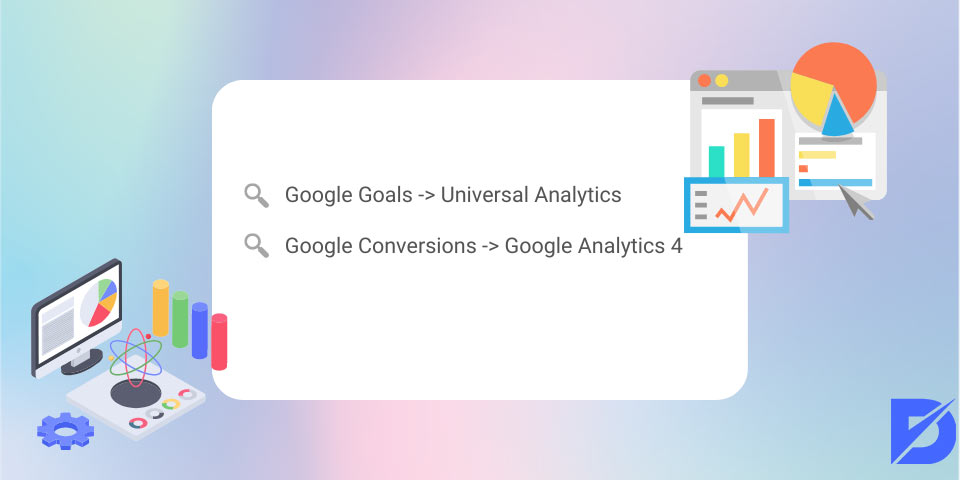
- Google Goals -> Universal Analytics
- Google Conversions -> Google Analytics 4
As you see, we may claim that the older version UA ‘speaks’ regarding goals, whereas the newer GA4 uses the term conversion. Careful, though: Once again, the two concepts are not contradictory or highly different from each other. It’s more a matter of subtleties, as we will see now. Check the Google Analytics 4 vs. Universal Analytics guide for more information.
What Are Conversions in Google Analytics
Google Analytics conversions are among essentials for anyone running a website aimed at successful Google usage. Why? What makes them so indispensable?
In fact, it’s not only about being successful on Google. It’s about the future of your entire business. That’s because a conversion represents nothing more than any online action you consider fruitful for your company, campaign, or project. That’s what you wish your website visitors would do, to put it simply. Want a typical example? A purchase made on your website is a conversion, and purchases are certainly very positive deeds for your business. Got it?
Undoubtedly, not all conversions in Google Analytics are one and the same. Indeed, there are several types of actions your visitors may take while navigating your website. Some may have a more modest impact, while others can contribute to your revenue more noticeably. That being said, one should never totally ignore or disdain supposedly ‘minor’ actions. Don’t forget that one thing always leads to another, especially in the business world. So even seemingly small gains may open the doors to more significant benefits.
Now if we had to present it in a nutshell, we would say that:
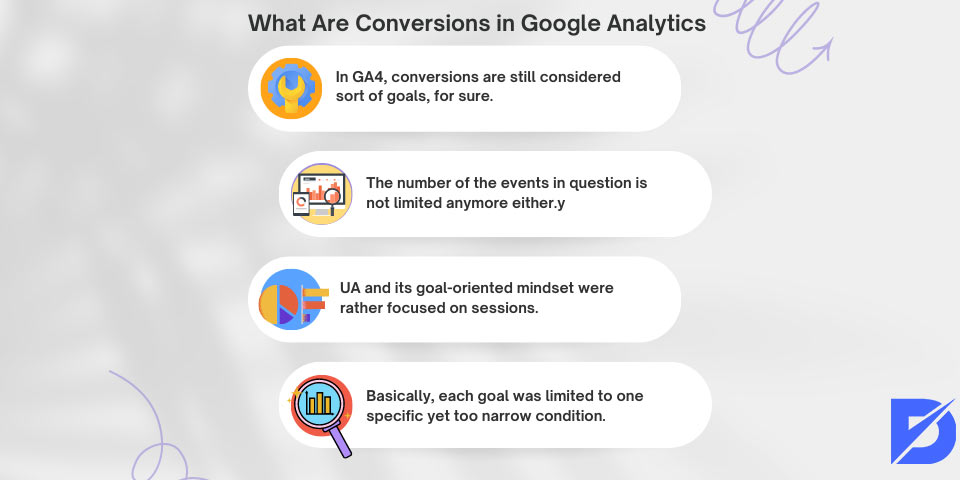
- In GA4, conversions are still considered sort of goals, for sure. However, they’re above all defined as events. This means they’re less restrictive and limited than the usual ‘scenario’ in UA.
- The number of the events in question is not limited anymore either. In UA, we used to have a limit of 20 goals per reporting view. If we happened to want more, we had to create different views or do tedious manipulations. With GA4, on the other hand, the number of target events is unlimited.
- UA and its goal-oriented mindset were instead focused on sessions. GA4 adopts another perspective and chooses to determine, above all, if an action has occurred.
- Remember the four types of goals in UA we mentioned above? Well, let’s admit that those were not so smart. Basically, each goal was limited to one specific yet too narrow condition. It’s not the case anymore, thanks to GA4. Now you can customize and track more complex (thus more realistic) events based on multiple conditions.
To be honest, in the long run, the experience and journey of each visitor are different. For example, imagine someone landing on a splash page of yours. Maybe this is precisely where they decide to enroll in your latest webinar. Meanwhile, perhaps they enjoyed your page design so much that they keep visiting and admiring it for several minutes every day, getting inspired by it. Why not, after all? And eventually, they participate in your webinar and make a purchase at the end of it.
Can you see how many interconnected events there are, just in the above example?
Setting Up Goals in Google Analytics 4
We hope things are a little more precise in your mind already, especially when it comes to goals and conversions. As we saw in the previous paragraphs, conversions are more flexible and comprehensive than goals, but nonetheless, they’re still goals. That’s why we will keep using both terms. Learn more about Google Analytics Goals.
So how does one set up goals in Google Analytics? Well, it logically starts with a configuration. Thus:
- Click on ‘configure’ and then on ‘events.’
- You should see a list of events predefined by Google Analytics 4. Consider them ‘default events,’ if you will:
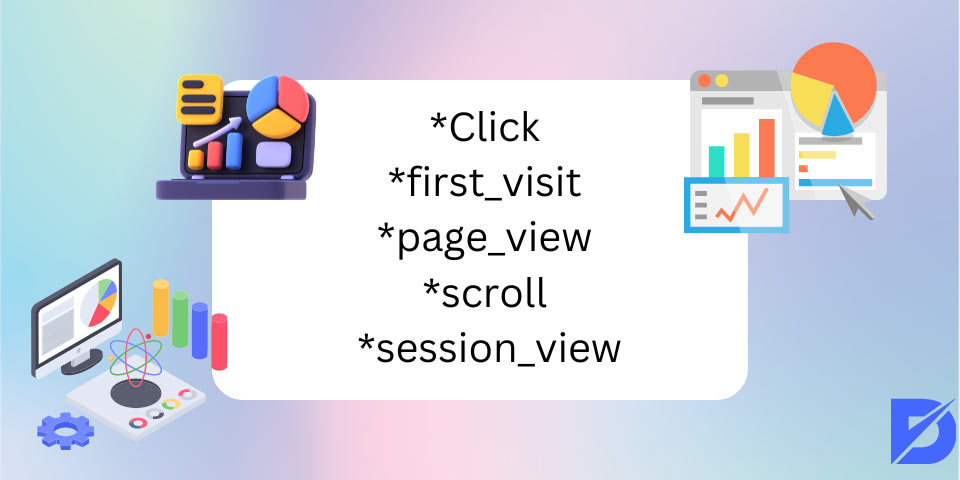
*Click
*first_visit
*page_view
*scroll
*session_view
But what if you want to customize things to your convenience? After all, we told you that you could do so, right? That’s kind of the point with GA4.
In such a case, choose among the two methods:

- Setting up a new event based on an existing option
- Setting up a new tag in Google Tag Manager
Setting Up a New Event Based on an Existing Option
Let’s suppose you’re focusing on page views at a particular moment. It could be anything: a welcome page, an announcement page, you name it. We’ve just seen above that there’s a predefined event called precisely ‘page_event.’ So what now? Actually, all we have to do is to use this existing option to create a new event.
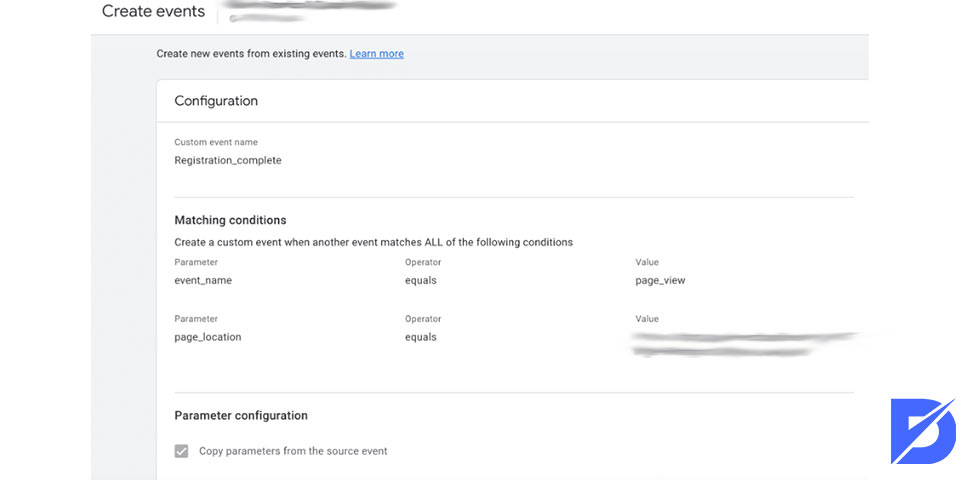
- Start by logging into your GA4 property.
- Go respectively to ‘Configure’ -> ‘Events’ -> ‘Create Event.’
- Now, give a specific name to your new event.
- Finish by confirming this new creation in your condition settings.
And that is all. From now on, there will be a new conversion event every time someone visits your target page(s).
Now let’s check and examine the second method.
Setting Up a New Tag in Google Tag Manager
If you prefer more flexibility, this one may be right up your alley. At the same time, it also ensures you increased control and precision regarding your conversions.
You may be willing to capture any kind of event. There are indeed several types of goals Google Analytics users do focus on. Let’s take one famous example and assume you’re tracking form submissions. As you know, these often serve as valuable feedback regarding engagement, interest, and so on.
Here’s how to proceed:

- Go to your Google Tag Manager and choose ‘Variables.’
- First-timers and new users should start with the ‘Configure’ section. Under it, one should see a subsection called ‘Forms.’ So if your goal is about form submissions, you will need to check all the related boxes within this subsection.
- Then select ‘Triggers.’ What we want now is to set up a generic form submission trigger because your intention here is to keep an eye on the form submission event via Google Tag Manager.
- Then go to preview mode. Enter your domain. Now you will conduct a test by filling out a form. If everything has been done correctly, you will see that form submit event and your variables in Google Tag Manager. Don’t forget to scroll down to find the form ID. Note down the related code (which will be required for the next steps).
- Now select ‘Tags’ and then ‘New.’ Give a name to your tag. It’s better to choose one that is short and easy to remember.
- Go to ‘Tag Configuration.’ Select ‘Google Analytics: GA4 Event’ to finalize the setup. Now the best thing to do is to assign a specific value under the ‘Event Parameters’ section. It will be displayed whenever the event is triggered. Caution though: You should set up the tag to fire only once per event. Otherwise, there may be complications, and you may end up with inaccurate data. Once done, hit ‘Save.’

- Remember the code you saved earlier? Now you will need to activate it. Click on + (top right corner). Select ‘Form Submission’ and ‘Some Forms.’ Browse the drop-down menu and find ‘Form ID.’ Copy the code and hit ‘Save.’
- Go to preview mode once more. Fill out another form on your target page.
- Then go to the form submission event you created previously. You should see your submission in Google Tag Manager if you completed all the steps correctly. Now go once again to ‘Tags’ and hit ‘Submit.’
- Finish the process by going back to your GA4 property. You may have to wait a few hours before seeing your new event displayed inside ‘All Events.’ Once it appears, you’re ready to mark it as a conversion. It will also be visible under ‘Conversions’ and other GA4 reports.
So What About Ideas?
We don’t want to sound as if we were letting you down on this one. But the answer is simple: When it comes to Google Analytics conversions, you’re the one to decide. We’ve already seen that the new GA4 allows you to track almost any event as a conversion. Some events are being tracked automatically, whereas, for others, you have now increased customization possibilities. Google, as mentioned above, Tag Manager is your number one support for the latter.
Just look at the examples below:

- first_visit
- page_view
- menu_click
- click
- scroll
- video_start
All of those combined may be among your objectives. Depending on your overall business strategy, you might also want to focus on some events more than others.
Remember when we said that even smaller gains do count? In the GA jargon, we call them micro-conversions. Video views are one example among others. Think of micro-conversions as the necessary stones and bricks that contribute to building the ‘palace.’
We also have macro-conversions. ‘Macro’ because they refer to events such as purchases, which have a more significant impact on your global results.
Long story short, you need to pick up and prioritize the conversions according to your own situation. It might be about the current phase of a marketing campaign you’re conducting, a new product launch, your trimestrial goals, or maybe an in-depth study of your target audience (and their behaviors). Always ask yourself what you’re aiming for through your website. That’s how you will select your target conversions accurately.
Conclusion
Today, we discussed Google Analytics Conversions ideas to give you a heads-up! We hope our article was helpful and you solved the mysteries of Google Analytics conversions. Hopefully, you will learn how to track conversions and set goals in Google Analytics. Don’t forget to carefully check all the steps above and start tracking your conversions smartly. Stay up to date with Dopinger!
Frequently Asked Questions About
Good news: GA4 will automatically mark four collected mobile app events as conversions. Besides, you’re free to add 30 extra app and/or web events as conversions. And if you’re on Google Analytics 360, then jackpot: that number goes up to 50!
It’s not an obligation. However, several good reasons for you to track conversions with GA4 exist. For instance, this kind of tracking allows you to measure better and thus increase your sales revenue. Moreover, it makes you regularly follow your visitors and prospects step by step (or ‘event after event’). So you become much more likely to respond to their demands right on time.
No, they aren’t. GA4 cares about privacy more than its predecessor Universal Analytics. Thus it is designed to work with and without cookies, depending on the user’s preferences.
Not exactly. UA is known for having a multi-channel comparison tool within which parameters were somewhat complicated. In GA4, users get a comparison feature. It allows you to change the attribution type in the report. You can choose among four types of attribution: cross-channel last click, cross-channel last engagement, Google Ads preferred last click, and Google Ads preferred last engagement.
Yes, GA4 is usually successful at detecting bot traffic. This becomes possible thanks to Google Research and the International Spiders and Bots List of the Interactive Advertising Bureau (IAB) collaboration.





No comments to show.